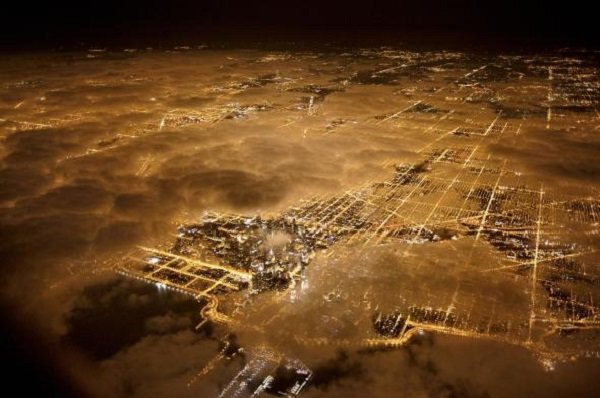
On Tuesday, scientists in the United Kingdom published a study charting the relationship between light pollution and the timing when trees produce buds. By observing four tree species, they found that on average, artificial light may cause trees to bud more than seven days earlier than their naturally occurring counterparts.
"It's correlative, so we can't prove anything. We can just show that there's a correlation," says Richard Ffrench-Constant, one of the study's authors. The research was published in the Proceedings of the Royal Society B.
Yet the study suggests that light pollution may be causing spring to come earlier. Or, at least, it's tricking plants into thinking that spring is happening earlier.
Early Bloomers
Light pollution occurs when streetlights and other artificial light sources brighten up the night sky, disrupting ecosystems and obscuring stars. In fact, 99 percent of people living in the United States and Europe can't see the Milky Way because of light pollution.
Light pollution contributes to climate change, too, by adding excess heat into the air.
"Lights have numerous effects," Ffrench-Constant says.
The study showed that European ash trees tend to bud about five days earlier in brighter areas compared with darker areas. Other trees tested, including European sycamores, European beech trees, and pedunculate oaks, burst about seven and a half days earlier in brighter conditions. Smaller plants growing directly under streetlights could be more heavily affected, the study notes.
The scientists used data collected by citizen scientists from 1999 through 2011. They combined that information with data quantifying artificial light recorded by the Defense Meteorological Satellite Program's Operational Linescan System during the same time period. The team also included air temperature data in the U.K., hypothesizing that the temperature of the air would correlate with budburst timing. But they were able to isolate light as a specific contributing factor.
If trees are budding earlier, this could have a larger effect on the surrounding ecosystem. Eric Vandernoot, the lab coordinator of theFlorida Atlantic University Astronomical Observatory, says light pollution alters plant cycles. It throws their bud dormancy out of whack, along with their growth patterns and time when they drop their leaves and fruit.
Thomas Rötzer, a professor at Technical University Munich, says light pollution will cause trees to grow in the direction artificial light is shining on them, allowing leaves closer to the light source to take on more chlorophyll and thus develop a lighter green color.
In wildlife, an example of light pollution in action happens when moths fly toward porch lights, says Cheryl Ann Bishop, communications director of the International Dark-Sky Association. When moths are attracted to the light, their predators are, too. Then the moths get eaten and can't serve their other natural purposes in that system.
"The bottom line is that the ecosystem is being disrupted," Bishop says. "It's not the natural order of things."
Whole Systems
Bishops adds that there's more research on light pollution's effects on wildlife than on plants. Ffrench-Constant's study is the first of its kind, monitoring how night-time lighting causes earlier budbursts. Studies already exist on the relationship between rising temperatures and earlier budbursts, and it's tricky to separate heat from light.
"You can't really separate out factors that work on synergy, and most environmental effects are synergistic," says Kerissa Battle, president and CEO of the nonprofit Community Greenways Collaborative, which works to restore ecosystems. "But statistically, you can isolate factors."
Vandernoot says the research could apply to warmer climates in general, rather than just the U.K. It would be more pronounced toward higher latitudes, he says, because that's where seasons are stronger.
Research on light pollution is so new, Bishop says, that scientists haven't studied it extensively. Some effects could be positive, but most are negative.
"Yes, I think spring's going to get earlier, by all measures," Ffrench-Constant says.
In addition to sorting out the effects of light pollution, Ffrench-Constant says the study also proves the importance of citizen scientists.
"These kind of important scientific studies can be aided by citizens taking notice of what's happening in their own backyard," says Battle.



Reader Comments
to our Newsletter